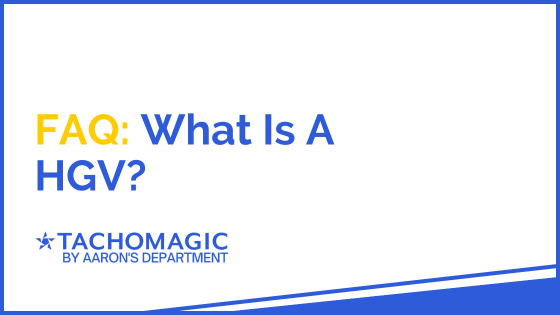What Is A HGV?
Interested in transport and logistics? The question "What is a HGV?" is a good starting place. Here's a quick look at what is a HGV, their significance, and the regulations governing their operation. By reading up on HGV's, businesses and individuals can gain a better understanding of modern logistics and transportation.
What Does HGV Stand For?
HGV is an acronym for Heavy Goods Vehicle. This term is primarily used in the United Kingdom and other European countries to describe trucks capable of carrying large, heavy loads exceeding 3,500kgs.

What Is A HGV? - Defining HGV
An HGV, or heavy goods vehicle, is any vehicle designed to transport substantial quantities of goods. These include articulated lorries, tankers, and flatbeds, each serving distinct purposes within various sectors such as agriculture, manufacturing, and retail.
The Economic Role of Heavy Goods Vehicles
Heavy Goods Vehicles are integral to global supply chains, since the majority of goods' destinations can't be reached by any other means - think rail, air, canal, sea. If you need 5 pallets of cinder blocks delivering your workshop, the cargo bike just isn't going to cut it. If something large or heavy needs delivering to a specific customer (I.E. not a port or a rail hub) then it'll need transporting by HGV.
By facilitating the movement of goods from manufacturing sites to markets, HGVs contribute significantly to economic stability and growth. Their impact is felt across all sectors, making them indispensable in our interconnected global economy.
What Does LGV Stand For?
The term LGV - Large Goods Vehicle - is often used interchangeably with HGV in the UK and parts of Europe. While we can't speak for all countries, in the UK, the two terms HGV and LGV mean the same thing.
We prefer to use HGV, since it's more commonly used, and LGV is often confused as meaning "Light Goods Vehicle".
The Varieties and Functions of HGV Vehicles
Lots of different vehicles fall into the "HGV" category, each designed to meet specific logistical needs. From refrigerated units for perishable goods to tankers for liquid transport, the type of HGV chosen directly impacts the efficiency and safety of cargo transport. Understanding the various types of HGVs allows businesses to optimise their operations and ensure compliance with safety standards.
Licensing and Regulations for HGVs
Operating an HGV requires adherence to strict regulatory standards, which include securing the appropriate licences and undergoing rigorous training. These regulations ensure that HGV drivers are well-prepared to handle the demands of operating large vehicles, an important consideration when it comes to maintaining road safety and efficiency in logistics.
Licensing for HGV Drivers
In many jurisdictions, driving an HGV requires a specific type of driving licence, different from those required for standard passenger vehicles. For instance, in the UK, drivers must obtain a Category C licence, which allows them to drive vehicles over 3,500 kg. Here are the key steps typically involved in obtaining an HGV licence:
- Medical Examination: Drivers must pass a medical exam to ensure they are physically fit to handle the demands of operating large, heavy vehicles.
- Theory Test: Similar to regular driving tests, there is a theory component that covers vehicle safety, hazard awareness, and industry-specific regulations.
- Practical Training: Practical skills are developed through specialised training courses that teach vehicle handling, safety procedures, and emergency responses.
- Skills Test: A comprehensive driving test must be passed, which assesses the driver’s ability to safely operate an HGV under various conditions.
Regulations Governing HGV Operations
HGV operations are subject to a range of regulations that cover vehicle standards, driver working hours, and cargo safety:
- Vehicle Standards: HGVs must meet stringent environmental and safety standards. This includes regular inspections and maintenance checks to ensure vehicles are safe to operate and meet emission standards.
- Working Hours: Regulations such as the EU’s drivers’ hours rules stipulate maximum driving times and minimum rest periods to prevent fatigue-related accidents. These are enforced through the use of tachographs, which record driving hours and rest periods.
- Load Safety: There are specific rules regarding the securing of cargo to prevent accidents due to shifting loads during transport.
- Environmental Regulations: In addition to emission standards, there are regulations aimed at reducing the environmental impact of HGV operations, such as limits on idling and the use of certain types of fuels.
The Future of Heavy Goods Vehicles
The future of HGVs is marked by innovation aimed at increasing efficiency and reducing environmental impact. Electric HGVs are emerging as a viable alternative to traditional diesel-powered vehicles, offering the benefits of lower emissions and reduced noise pollution.
Advancements in autonomous driving technology could revolutionise the HGV industry by improving safety and optimising logistics operations. Companies are investing in smart technologies that enable real-time tracking and diagnostics, improving route planning and vehicle maintenance. These developments not only promise to enhance operational efficiency, but also align with broader environmental goals by reducing the carbon footprint of heavy goods transportation.
Summary - What Is A HGV?
The answer to "What is a HGV?" is more than just a definition; it involves appreciating the vital role they play in our daily lives and the economy. Whether you call them HGVs or LGVs, their impact on the logistics and transportation industry is profound. As regulations evolve and technology advances, the HGV sector looks as if it will remain a to global trade and the efficient movement of goods.

About TachoMagic
TachoMagic is a tachograph analysis bureau, and supplier of automatic download devices for fleets across the UK. We've got decades of experience in the business, and we've decided to share a lot of it on our website!
If you or your work are interested in what we've got to offer, why not have a browse of our website or any of the links below.
Please don't hesitate to get in touch using the contact details below if you have any questions!
Further Reading - What Is a HGV?
If you've found our page, "What is a HGV" useful, we've linked below a few more of our guides below:
About The Author

Simon Theaker
Simon has over 20 years of dealing with tachograph analysis, and the technologies involved.
His in-depth knowledge and hands-on experience have made him a key behind-the-scenes member of the TachoMagic team.
Through his blogs, Simon hopes to make the lives of Fleet Managers easier, as he shares the answers to some of the most common questions he has received.

